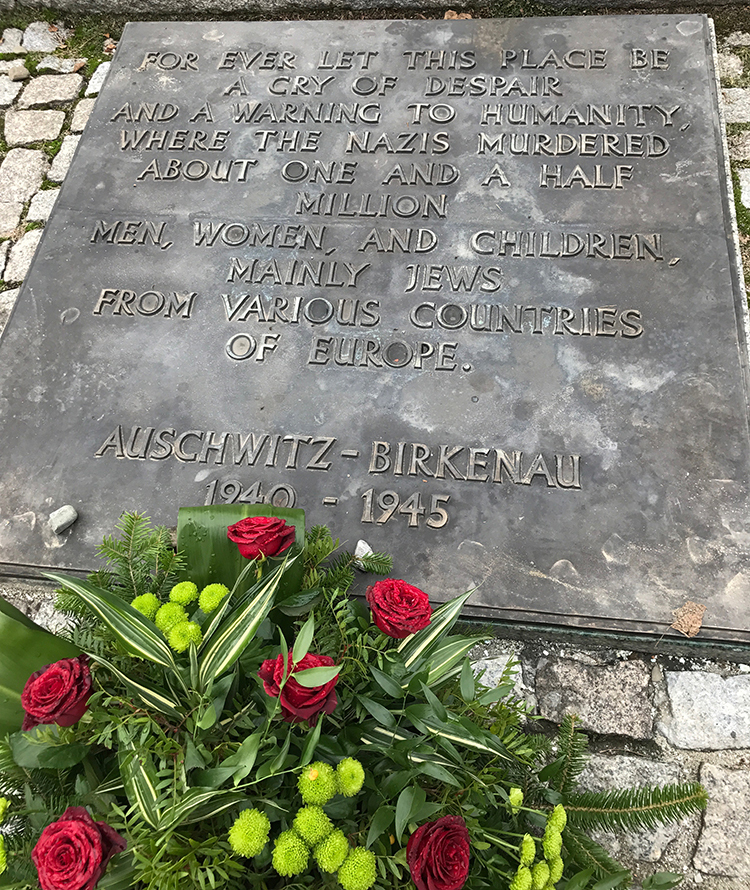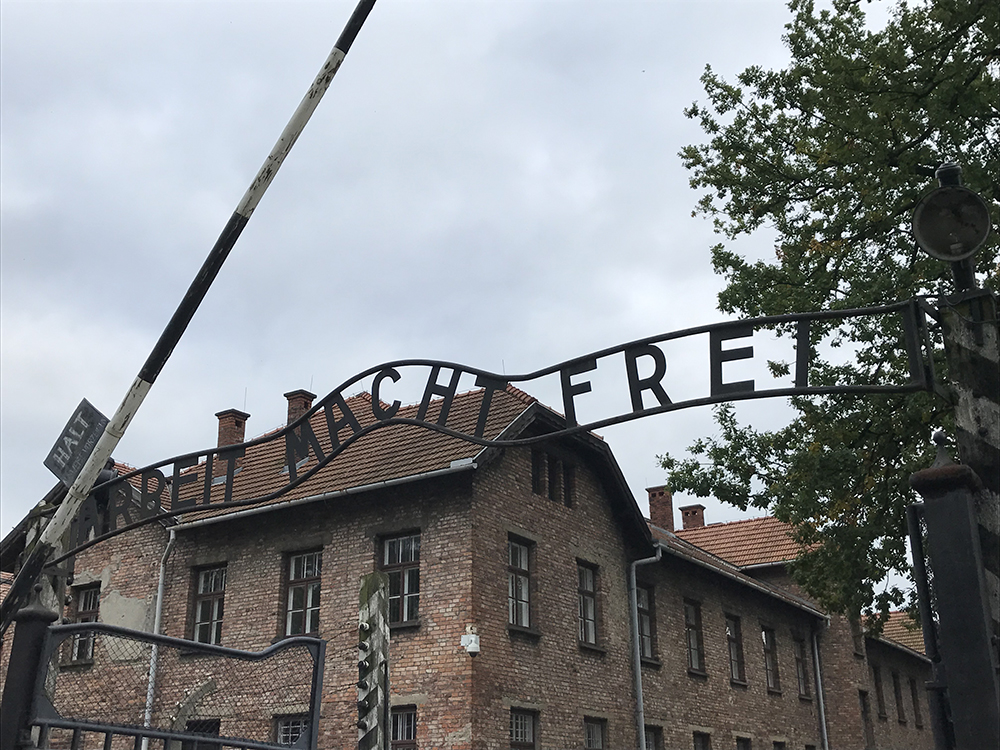The Holocaust means something different when you stand in the gas chamber at Auschwitz or the tunnels dug deep into the mountains by prisoners of the small Langenstein-Zwieberge concentration camp. How you view the attempts of Jewish resistance changes when you walk through the small neighborhoods where Jews were forced to live and pass through the buildings and doorways once inhabited by Jews.
Once you’ve walked those paths, the way you understand the Holocaust—and the way you teach it—irrevocably changes.
Twenty Arizona public educators took that journey in June with a program organized and sponsored by NAU’s Martin-Springer Institute. In the Footsteps of Survivors: Study Tour of Holocaust Memorial Sites in Poland and Germany followed the “footsteps” of two Holocaust survivor memoirs—Doris Martin’s “Kiss Every Step” (Doris and her husband are the founders of the Martin-Springer Institute) and Edward Gastfriend’s “My Father’s Testament.” Using the survivors’ stories as a guide, the teachers experienced in more intimate ways how the horrors and atrocities affected European Jews suffered in and after the Holocaust.
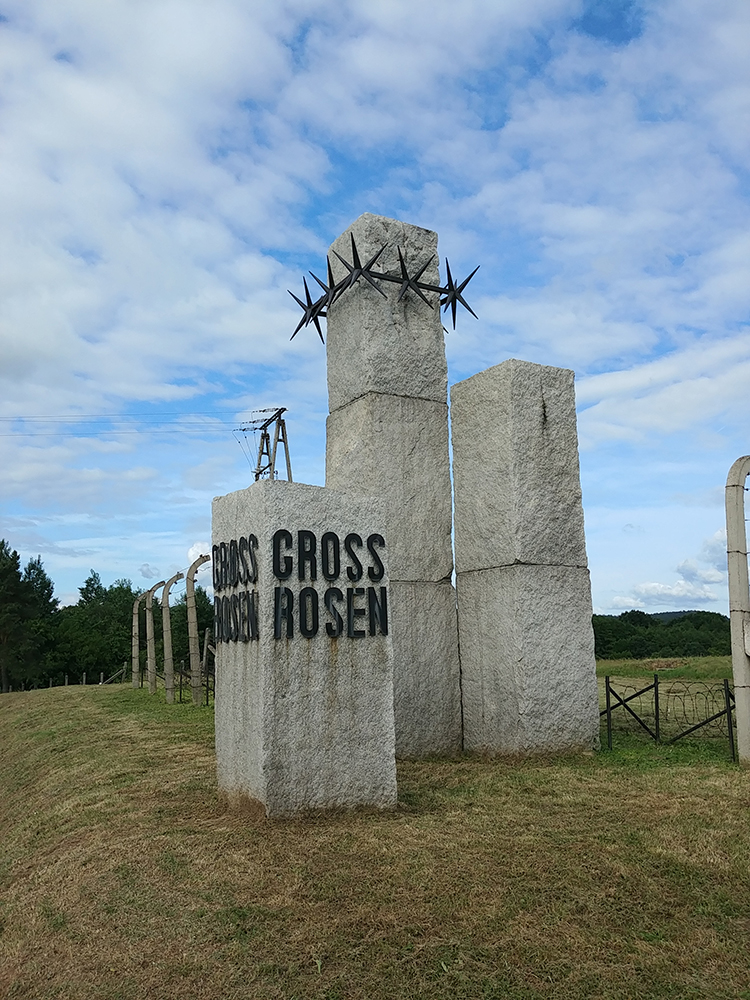
Martin-Springer Institute (MSI) director Björn Krondorfer, a Regents’ professor of religious studies, organized and led the trip; in the years before the trip, he coordinated with more than 20 Polish and German experts who met the group at each step of the tour. The group explored each location on foot, including the cities of Berlin and Krakow as well as remote former Nazi labor camps, now hidden in overgrown forests. The local experts shared the complexity of history and memory in Poland and Germany today. Those experts included curators, memory activists, historians, religious leaders, educators and specialized guides who shared lesser-known narratives and critical perspectives. The group also read out loud small parts of the survivor narratives at the locations where the events took place.
“We wanted the teachers to understand the Holocaust not just through reading texts but to be present in the actual locations to comprehend political geography, see the actual sites turned into memorials and to be exposed to experiential/sensual learning through landscape, sounds, smells and distances,” Krondorfer said. “We also wanted them to understand how the memorial sites are presented in modern-day Poland and Germany 80 years later.”
The MSI team, including program coordinator Melissa Cohen, spent more than two years planning and raising funds to ensure the study tour would be a once-in-a-lifetime experience for the teachers. The trip was funded by donations from the Conference on Jewish Material Claims Against Germany, the Molly Blank Fund of the Arthur M. Blank Family Foundation, G Shanahan and Marc Dubowy and the friends of the Martin-Springer Institute. NAU’s Center for International Education assisted with the logistics and acted as liaison with the tour agency.
This trip was especially timely since the Arizona Legislature passed a bill in 2021 requiring the teaching about the Holocaust in middle and high schools. There are textbooks that can do that, of course—but it’s not the same.
The NAU Review reached out to teachers who attended to ask about their experiences. Below are their stories in their words.
- Jeffrey Mann works at Flowing Wells High School in Tucson; he teaches honors world history to freshmen and biliteracy world history to a mix of freshmen and English language learners.
- Jaime Festa is the curriculum director for Lake Havasu Unified School District; prior to that, she was a high school government and economics teacher at Lake Havasu High School.
- Laura Romero-Ballesteros teaches seventh-grade social studies in Tucson.
- Amanda Johnson teaches sophomore and senior English at Corona del Sol High School in Tempe.
- Katherine Scholler teaches in the Social Studies Department at Coconino High School. She is taking a leave of absence for the upcoming school year to pursue a master’s degree in history at NAU.
How did you hear about this trip? Why did you apply?
JF: Somehow, an email came to my email inbox and spoke to my history teacher heart. Although I am not in the classroom, I work to develop, adopt, implement and evaluate all of the curriculum in our district. I work very closely with English and social studies teachers and knew this would be an opportunity to ensure that the students who go to school in Lake Havasu City would be exposed to a deeper understanding of the Holocaust. I also work with rural schools across Arizona. As an advocate for rural education, I want to make sure that rural students have exposure to the historical understanding of the state-led, systematic persecution and killing of the Jews and other people deemed less than or a threat to the Nazis and connection to the lived experiences of those who were impacted by the Holocaust.
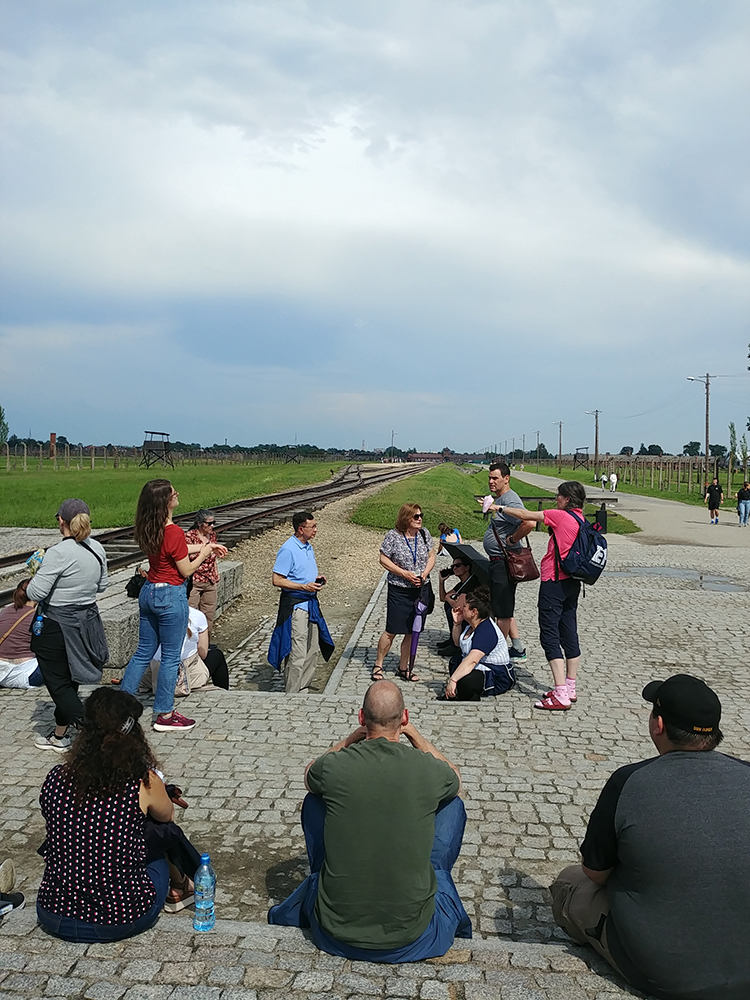
LR-B: I was part of the book group that read and discussed both books. I applied for various reasons. I have always believed that to truly understand and appreciate history, one must go where history took place. I felt both stories of Doris and Eduard where stories I wanted to learn more, and I felt in order to feel some degree of what they each went through I would need to follow their footsteps from start to finish. I had previously visited Auschwitz but never had the opportunity to visit labor camps or other concentration camps and wanted to see for myself what these terrible places looked like and get a sense of the trauma prisoners had to endure on a daily basis.
Read the rest of the teachers’ answers.
What stood out about the trip?
AJ: There are so many incredible insights and impressions I will treasure from this experience—it facilitated my growth as an individual and an educational professional. The impact of our visit to Auschwitz-Birkenau will forever be imprinted on my psyche: walking the ground where so many struggled, resisted and were murdered brought so many emotions and questions to the surface; I know I will be processing the experience for a long while. In particular, seeing artifacts stolen from the victims of the Nazi regime and its collaborators brought me to an emotional low; I couldn’t imagine that human beings would take everything—even the most basic human dignities—from other human beings. Processing that this inhumanity was the result of human choice created so many questions that I will wrestle with for a while.
KS: The loss of Jewish life and culture is still so clearly seen and felt in the various cities that we visited. To see remnants of this life was hallowing—for example the indentation of a missing Mezuzah in a door frame, or a menorah welded into the metal work on a balcony or the gap in a row of buildings where a synagogue had been burned down, all in the midst of a city going about its daily affairs, spoke volumes as we toured these areas where few to no Jewish people now live.
The other experience I’ll recount here was the most emotional and impactful one for me. We went to Langenstein-Zwieberge Memorial, the last camp where Edward was imprisoned before liberation. Here we saw a mass grave, where Edward’s cousin Nathan’s body was thrown after he died from dysentery. They had survived the past three camps and death marches together, leaning on each other as their source of strength to continue on. His death was so close to liberation. At the site of the mass grave, another member of our group, Lisa Carotenuto, and I jointly read a passage to the group from his memoir describing Nathan’s death and Edward’s reaction. To read it again at this spot was profoundly sad, but also a way to honor and remember him.
JM: Framing this inherently historical trip around literature (a pair of survivor accounts) rather than “traditional history” was incredibly effective. Doing this allowed me to center my experiences during the trip in those personal narratives (therefore emotions) as opposed to experiencing them through “historical analysis” (therefore intellectually). The difference was profound for me, as it pushed me to confront the history of the Holocaust in a way that makes me uncomfortable, vulnerable and ultimately open to the process of growing. I was impressed with Björn’s deft handling of these dynamics. He pushed and prodded us through regular reflective activities helping us create meaning out of the cacophonous thoughts and impressions in our heads while simultaneously nurturing a safe, accepting space for us to engage that way. I know that I felt safe to struggle with my feelings and give them voice within the group. We were set up to succeed with these reflections due to their regularity, the individual accountability required and Björn’s varied grouping strategies.
Read all of the teachers’ unabridged answers.
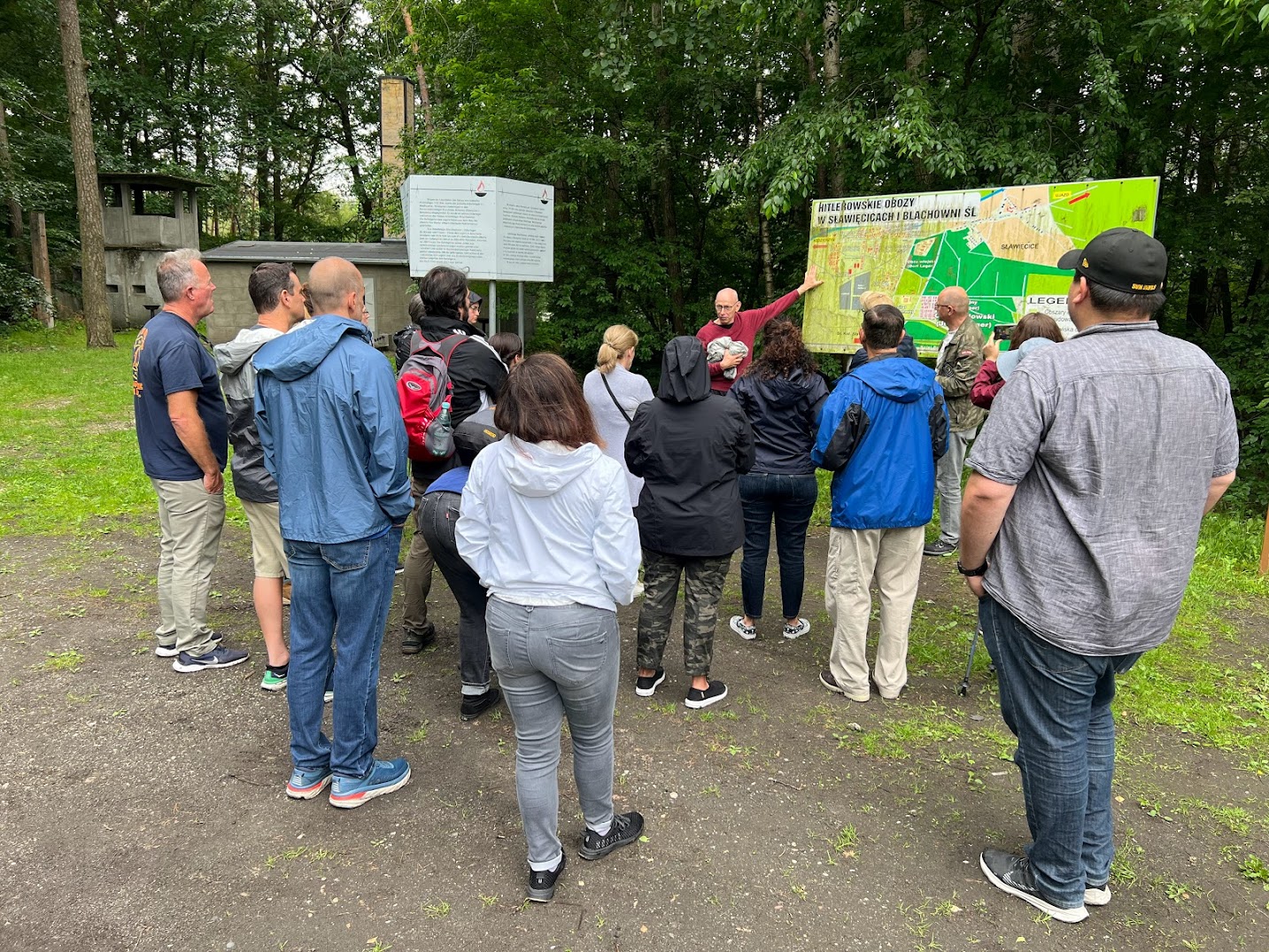
What did you learn about the Holocaust?
JF: Being able to follow the paths of Doris Martin Springer and Edward Gastfriend contextualized the experiences of Holocaust survivors and helped me understand that every story is unique and deserves to be told. The stories of the human lives destroyed can’t be told, and it is up to us to ensure government-backed atrocities and persecution of individuals does not happen. As educators, we must be vigilant in teaching young people how to not become perpetrators.
JM: Two things jump out to me:
- How deeply ingrained the prejudices/conflicts in that part of the world are and how many different fault lines those conflicts have been drawn over time, whether religious, class-based, “race” based, nationalistic or ideological. It is complex. It is nuanced. It is deeply felt. It is messy. They are neighbors.
- How uniquely individual people’s responses to the Holocaust/World War II/Nazi period are for the people who lived through them and subsequent generations. In my head, I knew how much denial there was or people’s tendencies to hold their noses and feign ignorance while distancing themselves from the unpleasant past. It was very different to see it in person, though, juxtaposed as it was with examples of unblinking ownership of Nazi atrocities. I had never really thought about the ways successive generations challenged the sanitized narratives their parents, grandparents and great-grandparents claimed or about the emotional impact such conflicts could have. Seeing the different ways that “official” responses developed in Poland, Western Germany and Eastern Germany was eye-opening too. The underlying ideologies between formerly communist governments and western-led governments was clear too.
The parallels were painfully vivid between the responses we saw in Central Europe and the responses we face in the U.S. confronting (or denying) the injustice, racism, vitriol and politicization of our own shameful history. As before, these aren’t new to me as intellectual constructs or phenomena, but their presence was more immediate and pronounced in this context. It was good for our group to confront these realities as we did.
AJ: Perhaps one of the most important overall lessons I began to process is that persecution and genocide can only occur as a result of human choices—to persecute, but also to be complicit in our words, actions, silence and inaction.
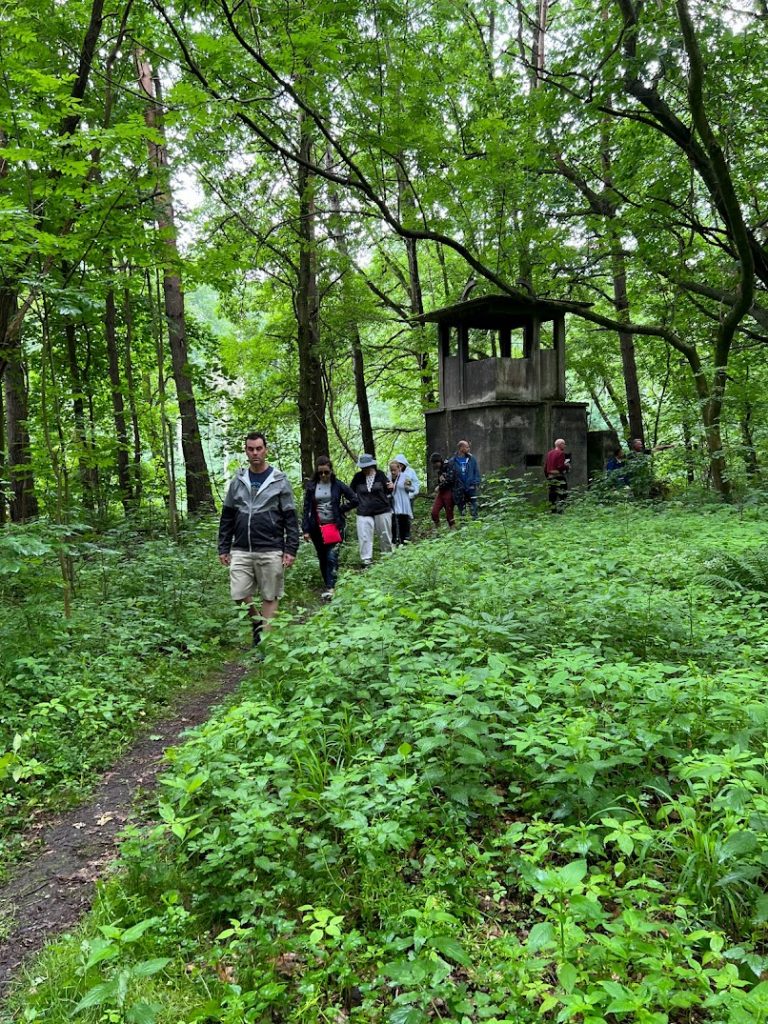
LR-B: In general, my understanding was based on statistics and some stories. Being part of this educational opportunity, I was able to learn of specific treatment, various locations and chain of command, but most importantly, my misconceptions or questions were cleared. Although I did walk away with questions related to humanity and the actions/motivations of people, I was able to gain a better understanding of how and why the “Final Solution” was proposed, the people behind it and the sheer scope of how it almost succeeded. Going to Wannsee where all the initial decisions were made and learning of the men behind these decisions was information I did not have a full understanding of but know I can use this information to answer questions my students consistently ask.
KS: I realized during the trip that the more you learn about the Holocaust, the less you understand. The word of the trip for me was incomprehensible. Because of this trip, I now have a more functional understanding of the administration of it and the geography of the genocide of the Jewish people during WWII, and I took a multitude of notes over the course of 17 information-packed days that vastly expanded my knowledge base. Yet at every turn, this trip confronted me with the fact that the Holocaust isn’t something we can ever (or should ever) comprehend. Even so, it only further solidified why Holocaust education is vital. Because what also came starkly into view is that even if we cannot comprehend it, we are capable of it. Knowing that and learning the depths of it is terrifying and uncomfortable, but also integral to preventing it from happening again and understanding our role in the present world. This trip taught me that in more ways than I can adequately express.
Read all of the teachers’ unabridged answers.
How do you anticipate the experiences you had on this trip informing your teaching?
KS: The most important goal in my teaching is building empathy and critical thinking. This trip provided me with a wealth of knowledge that will add depth to their learning of the Holocaust and help them make connections to their lives today. I feel that I can better answer questions and develop questions for students. I want to center the memoirs of Doris and Edward in conjunction with photos and materials from the trip, to allow them to feel more intimately what Holocaust victims experienced and how lives were impacted. I was also thinking that it would be great if I could possibly set up a virtual meeting with students and one of the guides we had on the trip, to give them a part of that experience as well. I would also use these memoirs to develop group discussions that have them ask questions of themselves, their peers and the greater society to dissect how this genocide happened and what steps have to be taken to prevent it from happening again. I look forward to meeting again with the other educators on our trip to brainstorm more ways to incorporate this experience into the classroom.
AJ: The experience of this journey will reflect in all aspects of my teaching—helping my students to make humane choices and develop into responsible, benevolent global citizens.
Read all of the teachers’ answers.
